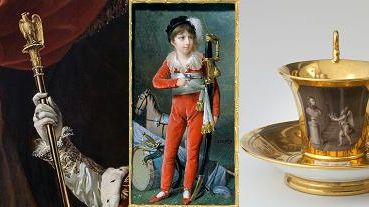
Press release -
Staging Power – Napoleon, Karl Johan, Alexander opens 30 September
On 30 September, Nationalmuseum opens its autumn exhibition Staging Power – Napoleon, Karl Johan, Alexander.
The exhibition presents 410 artifacts in their historical context, all
of which have some connection with one or other of the protagonists. The
lives of the three rulers are interwoven with art in an unprecedented
exhibition on the art of governing through art.
Nationalmuseum is joining forces with the State Hermitage, St. Petersburg, to present this autumn’s magnificent exhibition, Staging Power – Napoleon, Karl Johan, Alexander.
Featuring a wealth of historical artifacts and fine artisan wares, the
exhibition is all about the art of governing through art. In all, some
410 artifacts will be on show – a splendid selection of portraits,
costumes, jewellery and other first-rate craftsmanship.
Napoleon, Karl Johan and Alexander were all skilful propagandists who knew how to use art to reflect their self-image and demonstrate the legitimacy of their claim to power. The exhibition focuses on how these three rulers influenced art and were, in turn, influenced by art. Even objects serving the most commonplace purposes could carry a political message. One example is the toothpick case carried by Bernadotte’s delegate to show that he represented the future King Karl Johan in the negotiations on the Swedish succession. Another example is a decorative cup featuring a motif in which a genie is shown carrying the Swedish crown towards a bust of Karl Johan. The inscription reads “Merit is duly rewarded”, reflecting Karl Johan’s own view of his legitimacy. He had ascended to the throne not by birth but on his own merits.
The three rulers sought to use art for their own ends but also developed a style that ran counter to the prevailing ideals. The Empire style evolved in France under Napoleon, taking ancient Rome as one of its models, and is typified by its use of fire-gilt bronze, dark mahogany, porphyry, colourful fabrics and military emblems. Symbols of war abounded, even in civilian contexts. France greatly influenced artistic trends in both Russia and Sweden, where the Empire style did not reach its zenith until after Napoleon’s overthrow in 1815. Karl Johan brought the French Empire style with him to Sweden, where it continued to dominate interior design and applied art until the 1840s. During his reign he built Rosendal Palace as a summer retreat and refurbished Rosersberg Palace, both of which have Empire-style interiors unique in Sweden. In addition to various pieces of craftsmanship from the period, Nationalmuseum has borrowed the entire interior of Karl Johan’s bedchamber for the exhibition, as well as his camp bed.
Jewellery and medals were commonly worn by men and women alike as a mark of elevated social status, frequently with a political subtext. The design of both was influenced by the Empire style. Precious stones and other materials were widely used, mounted in gold. Napoleon was especially fond of giving cameo jewellery to his two consorts. Cameos had a history of their own, often stretching back to antiquity, which made them particularly attractive to Napoleon. Several pieces of Empress Josephine’s jewellery are now worn by members of the Scandinavian royal families.
To coincide with the exhibition, Nationalmuseum is publishing an impressive catalogue featuring a lot of previously unpublished research that interweaves the stories of the three rulers with art history. The catalogue includes an introduction to the exhibition and a listing section describing all the exhibits. It also contains various academic articles about the protagonists and art, along with historical maps and family trees. www.nationalmuseum.se/stagingpowercatalogue
The exhibition runs from 30 September 2010 to 23 January 2011.
An adapted version for Russian audiences will appear at the State Hermitage, St. Petersburg, in the spring of 2011.
Further information
Magnus Olausson, exhibition curator: mon@nationalmuseum.se, +46 8 5195 4371
Hanna Tottmar, press officer: htr@nationalmuseum.se, +46 8 5195 4390
Anna Jansson, press officer: ajn@nationalmuseum.se, +46 8 5195 4391
Captions
Detail from François Gérard, Napoleon I in his Coronation Robes © Alexis Daflos, Kungl. Husgerådskammaren; Jean-Baptiste Isabey, Oscar (I) as a child © Alexis Daflos/Kungl. Husgerådskammaren; The firm Dartes Frères, Paris, Display cup with a genie lifting up the royal crown of Sweden to a bust of Karl Johan© Alexis Daflos, Kungl. Husgerådskammaren;Unknown Italian artist, Cameo with profileportrait of Joséphine Bonaparte© Nationalmuseum
Special thanks to the Ad Infinitum Foundation for its generous support
of the exhibition, to Sven Hagströmer and Lage Jonason for their support
of the catalogue, and to our benefactor Moët & Hennessy.
Nationalmuseum’s sponsors and partners: Accenture, Fagerhults Belysning,
Svenska Dagbladet, Fältman & Malmén, Clarion Hotel Stockholm.
Categories

